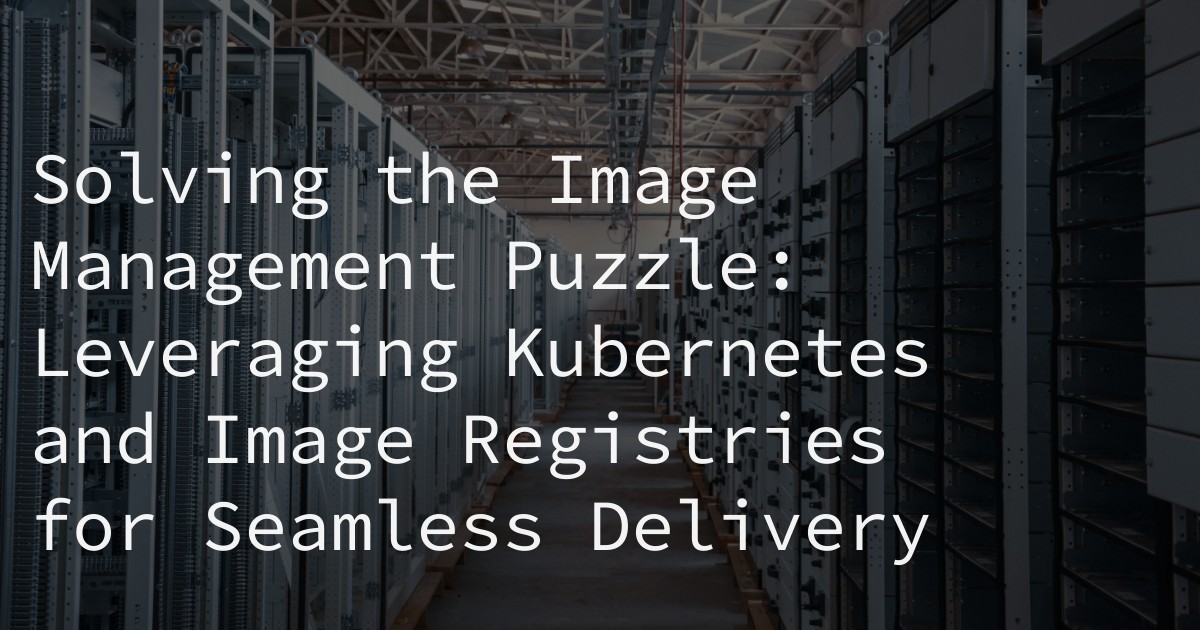
10 Nov Solving the Image Management Puzzle: Leveraging Kubernetes and Image Registries for Seamless Delivery
Image management is a crucial aspect of modern software development, especially in the context of containerization and cloud-native computing. With the rise of Kubernetes and image registries, the process of managing and delivering images has become more complex and challenging. As a SEO and Cloud Computing expert, I have extensive knowledge of optimizing content and pages for improved page rank and a deep understanding of all things Kubernetes, Docker, and cloud-native computing. In this article, I will delve into the challenges of image management in Kubernetes and how leveraging Kubernetes and image registries can help overcome these challenges for seamless delivery. The title for this article is “Solving the Image Management Puzzle: Leveraging Kubernetes and Image Registries for Seamless Delivery” under the category of Image Registries.
Containerization and Image Management Basics
Before we dive into the challenges of image management in Kubernetes, it is essential to understand the basics of containerization and image management. Containerization is the process of packaging an application and its dependencies into a lightweight, portable container that can run consistently across different computing environments. Image management, on the other hand, involves the process of creating, storing, and delivering these containers to different environments.
Challenges of Image Management in Kubernetes
While Kubernetes offers many benefits for managing and deploying containers, it also presents several challenges when it comes to image management. Let’s take a closer look at these challenges and how they can be addressed.
Image Dependency Management
One of the primary challenges of image management in Kubernetes is managing dependencies between images. In a microservices architecture, applications are composed of multiple containers, each with its own set of dependencies. This can quickly become complex and challenging to manage, leading to potential compatibility issues and deployment failures.
Image Versioning
Another challenge is managing image versions. As applications evolve, so do their dependencies, leading to the need for new image versions. In Kubernetes, managing these versions and ensuring that the correct version is deployed can be a time-consuming and error-prone process.
ALSO READ
Image Security
With the rise of cyber threats, image security has become a significant concern for organizations. In Kubernetes, images are pulled from public or private registries, making it crucial to ensure that these images are secure and free from vulnerabilities.
Image Storage and Distribution
Kubernetes clusters can span multiple nodes, making it challenging to manage image storage and distribution. This can lead to performance issues and delays in deployment, especially when dealing with large images.
ALSO READ
Image Registry Management
Kubernetes supports multiple image registries, making it challenging to manage and maintain these registries. This can lead to inconsistencies and difficulties in tracking and managing images across different registries.
Image Scalability
As applications scale, so does the number of containers and images. This can lead to scalability challenges, especially when dealing with large images and multiple clusters.
Utilizing Kubernetes and Image Registries for Efficient Delivery
To overcome these challenges, organizations can leverage Kubernetes and image registries for efficient image management and delivery. Let’s explore how this can be achieved.
Leveraging Kubernetes for Image Management
Kubernetes offers several features that can help with image management, such as the ability to define dependencies between containers and automatic image pull policies. By leveraging these features, organizations can ensure that the correct image versions are deployed, and dependencies are managed efficiently.
Benefits of Utilizing Image Registries
Image registries offer several benefits for image management, such as centralized storage, version control, and security. By utilizing image registries, organizations can ensure that images are stored securely and consistently across different environments.
Integration of Image Registries with Kubernetes
Integrating image registries with Kubernetes can help streamline the image management process. By integrating registries with Kubernetes, organizations can pull images directly from the registry, reducing the need for manual image management.
Best Practices for Seamless Integration
To ensure seamless integration between Kubernetes and image registries, organizations should follow best practices such as using a single registry, implementing image scanning for security, and automating image builds and deployments. These practices can help organizations overcome the challenges of image management and achieve efficient delivery.
Conclusion
In conclusion, image management in Kubernetes can be a complex and challenging process, but by leveraging Kubernetes and image registries, organizations can overcome these challenges and achieve seamless delivery. By following best practices and utilizing the features of Kubernetes and image registries, organizations can ensure efficient image management and deployment, leading to improved performance and security for their applications.
RELATED ARTICLES:



Sorry, the comment form is closed at this time.